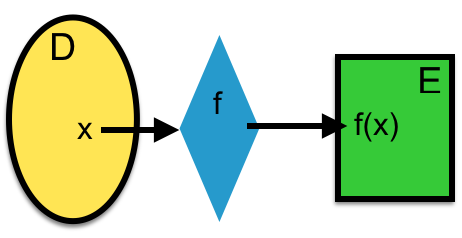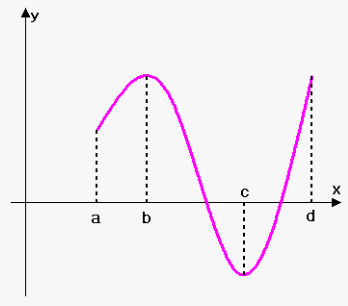

Criterion: one input ==> ONE outputExamples of functions: table representation, formula, graph, etc.
| Category | score |
|---|---|
| Homework | 98 |
| midterm 1 | 100 |
| midterm 2 | 82 |
| midterm 3 | 96 |
| final exam | 100 |
Example of function evaluation:
If \(f(x)=2x^2-x\), then \(f(a+h) = 2(a+h)^2-(a+h) = 2(a^2+2ah+h^2)-a-h=2a^2+2h^2+4ah-a-h.\)
Exercise:
\(f(x) = 2x^2-x\; \text{and}\; h\neq 0,\; \text{evaluate the "difference quotient"}\; \frac{f(a+h)-f(a)}{h}.\)
Answer: \(4a+2h-1.\)
Graph of \(f\) consists of all (\(x,f(x)\)) pairs. Namely, all (input,output) pairs: \[\{ (x,f(x)) | x\in D \}.\]
Find relevant information given the graph of a function, cf. Figure 6.
The Vertical Line Test: A curve in the \(xy\)-plane is the graph of a function of \(x\) if and only if no vertical line intersects the curve more than once. (Recall the criterion: one input ==> ONE output)
Exercise: See the x-y plot below. Is the curve(blue) a graph of a function?
Answer: yes.

Example. Plot \(x=y^2-2.\) See Figure 14(a). Is it a graph of a function? Answer: no.
Exercise: Is \(y\) a function of \(x\)? (a). \(y=x^2+2\); (b). \(y^2=x+2\)
Answer: (a) yes; (b) no.

Domain Convention: Given formula of a function \(f(x)\) and the domain is not stated explicitly, the domain is the set of all numbers for which the formula makes sense and defines a real number.
Exercise:
Determine the domain and range of a function.
(a). \(f(x)=\sqrt{1-2x}\) \(\quad\)
(b). \(f(x)=\sqrt[3]{1-2x}\) \(\quad\)
(c). domain of \(f(x)=\frac{1}{x^2-x}.\)
Answer: (a). domain: \(x\leq \frac{1}{2}\);
range: \([0,\infty)\).
(b). domain: \(-\infty<x<\infty\);
range: \((-\infty,\infty)\).
(c). domain: \(\{x\; |\; x\neq 0,\; x\neq 1\}\) or in interval notation: \((-\infty,0)\cup(0,1)\cup(1,\infty)\).
See (p.19) 7--10, 31--37 for more problems.
Piecewise Defined functions: Functions that are defined by different formulas in different parts of their domains.
Examples(sketch the graphs of the functions below)
\(f(x) = \begin{cases} 1-x & \text{if}\;\; x\leq -1\\ x^2 & \text{if}\;\; x > -1 \end{cases} \)
\(f(x)=|x|\)
Excersies: even or odd or neither? \(\quad f(x)=x^3+x, \quad g(x)=x^2+x, \quad h(x)=\frac{x^4}{x^2+5}\)
Answer: \(f\) is odd, \(g\) is neither, \(h\) is even.
See (p.23) 73--78 for more exercise.
\(f\) is increasing on an interval \(I\) if
\(f(x_1)<f(x_2)\) whenever \(x_1<x_2\) in \(I\).
(graph: an up-going curve)
\(f\) is decreasing on an interval \(I\) if
\(f(x_1)>f(x_2)\) whenever \(x_1<x_2\) in \(I\).
(graph: a down-going curve)

p.19 3, 4, 7--10, 27--37, 73--78